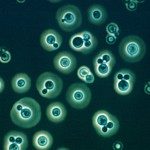Lien vers Pubmed [PMID] – 15585878
J. Immunol. 2004 Dec;173(12):7513-20
The capsular polysaccharide glucuronoxylomannan (GXM) of Cryptococcus neoformans has been shown to interfere with neutrophil migration. Although several receptors have been implied to mediate this process, the structural perspectives are unknown. Here, we assess the contribution of 6-O-acetylation and xylose substitution of the (1–>3)-alpha-d-mannan backbone of GXM, the variable structural features of GXM, to the interference with neutrophil migration. We compare chemically deacetylated GXM and acetyl- or xylose-deficient GXM from genetically modified strains with wild-type GXM in their ability to inhibit the different phases of neutrophil migration. Additionally, we verify the effects of de-O-acetylation on neutrophil migration in vivo. De-O-acetylation caused a dramatic reduction of the inhibitory capacity of GXM in the in vitro assays for neutrophil chemokinesis, rolling on E-selectin and firm adhesion to endothelium. Genetic removal of xylose only marginally reduced the ability of GXM to reduce firm adhesion. In vivo, chemical deacetylation of GXM significantly reduced its ability to interfere with neutrophil recruitment in a model of myocardial ischemia (65% reduction vs a nonsignificant reduction in tissue myeloperoxidase, respectively). Our findings indicate that 6-O-acetylated mannose of GXM is a crucial motive for the inhibition of neutrophil recruitment.


